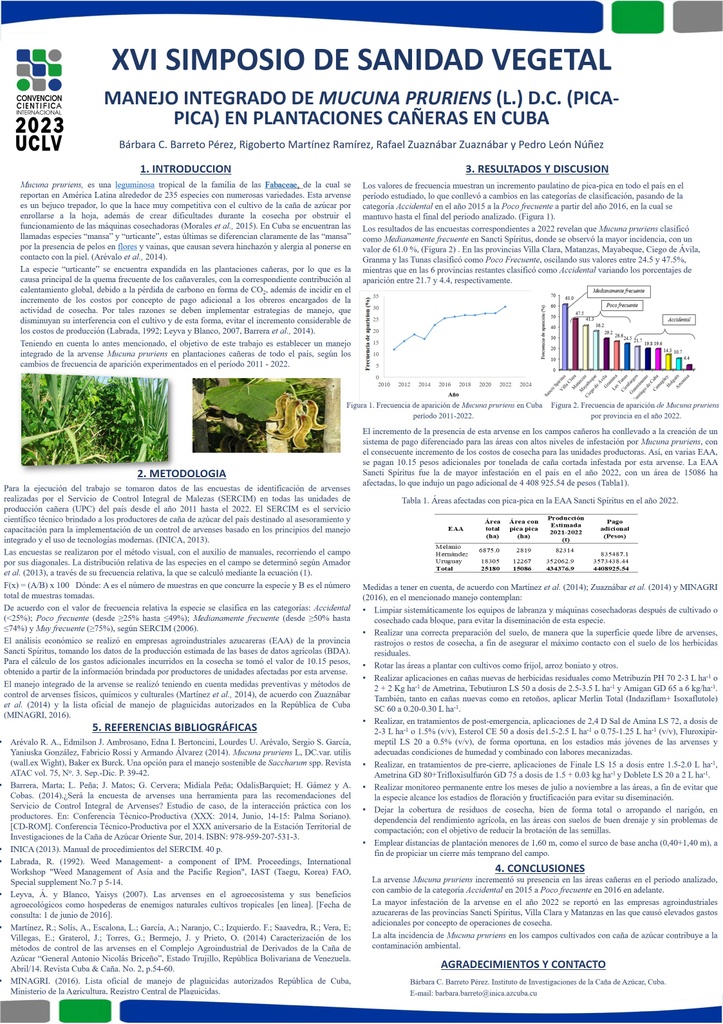Executive Secretary

10th International Scientific Conference on Agricultural Development and Sustainability
16th Symposium of Plant Protection

Abstract
Mucuna pruriens (L.) D.C.) (Pica-pica) is a weed that that currently increases in the sugarcane plantations of Cuba, belongs to the class Magnoliatae, family Fabaceae, genus Mucuna. Due to its morphological characteristics and stinging power, it creates difficulties for mechanization and handly harvest, inducing additional payments for manual cutting and a negative environmental impact, due to the burning of fields with high infestation. The work was carried out with the aim of proposing a management that attenuates the presence of pica-pica in the areas planted with sugar cane in Cuba. For that, we evaluated the frequency of occurrence changes in the period 20011-2023 at the national level, based on the data from the surveys of the Integral Weed Control Service (SERCIM). Its distribution was determined through the relative frequency, being classified according to the frequency value in the categories: Accidental, Uncommon, Moderately frequent and Very frequent. The average values of frequency showed that the species grew during the studied period, changing in the recent years from the Accidental to the Uncommon category. Besides, it was made an economic evaluation of infected areas that showed an increase of harvest costs. An integrated management strategy base on the employ of cultural, physical, and chemical management.
Resumen
Mucuna pruriens (L.) D.C.) (Pica-pica) es una arvense que actualmente se incrementa en las plantaciones cañeras de Cuba, pertenece a la clase Magnoliatae, familia Fabaceae, género Mucuna. Por sus características morfológicas y poder urticante crea dificultades a la mecanización y al hombre durante la cosecha, induciendo a pagos adicionales por concepto de corte manual y un impacto ambiental negativo, debido a la quema de los campos con alta infestación. El trabajo se realiza con el objetivo de establecer un manejo que atenúe la presencia de pica-pica en las áreas plantadas de caña de azúcar en Cuba. Para ello se evaluaron los cambios de frecuencia de aparición en el período 2011-2022 a nivel nacional, a partir de los datos de las encuestas del Servicio de Control Integral de Malezas (SERCIM). Se determinó su distribución a través de la frecuencia relativa de aparición, clasificándose de acuerdo con este valor, en las categorías de: Accidental (<25%), Poco frecuente (desde ≥25% hasta ≤49%), Medianamente frecuente (desde ≥50% hasta ≤74%) y Muy frecuente (≥75%). Los valores promedios de frecuencia aparición mostraron que la especie creció, pasando en los últimos años de la categoría Accidental a la Poco frecuente. Se realizó además una valoración económica de las áreas infestadas que mostraron un incremento de los costos por concepto de pago adicional durante la cosecha. Se establece una estrategia de manejo integrado basada en el empleo de medidas culturales, físicas y químicas.
About The Speaker

M. Sc. Bárbara Barreto Pérez

Discussion

